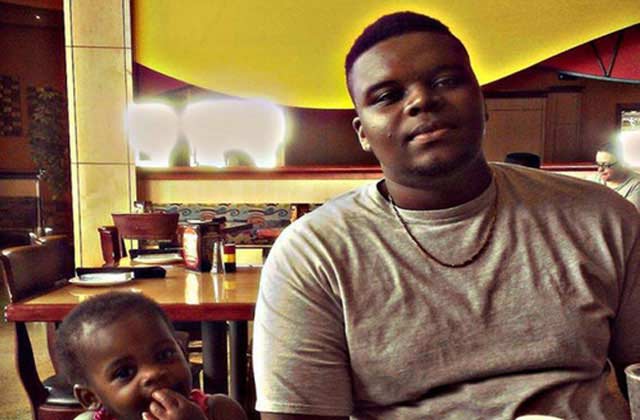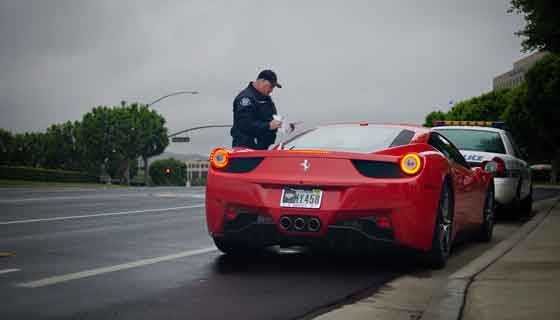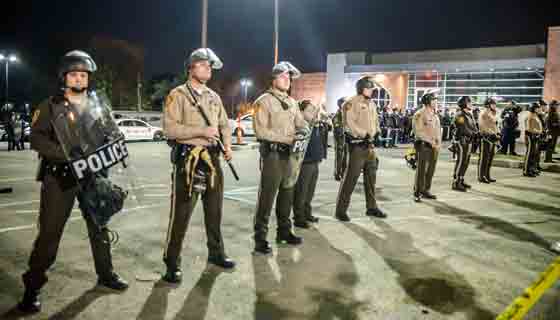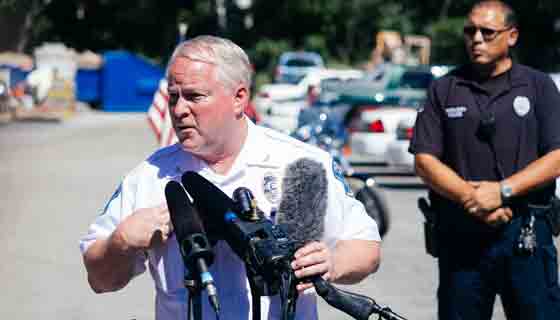The fatal police shooting of unarmed 18-year-old Missouri resident Michael Brown ignited protests in his hometown of Ferguson late Sunday night that continued into Monday morning and afternoon.
Residents held a vigil for Brown in the St. Louis suburb where he died after a police officer shot him 10 times Saturday night. His body was left in the street for four hours before being removed. The FBI officially launched a civil rights investigation into his death Monday afternoon.
Police in riot gear surrounded the peaceful memorial, armed with shotguns and tear gas. Some held attack dogs on leashes.
The vigil transitioned into a demonstration. Residents chanted, “No justice, no peace!” as they marched through the neighborhood amid hundreds of police officers. Some held their hands up to show they were unarmed: “Don’t shoot me,” they shouted. Brown’s mother, Lesley McSpadden, told reporters, “My son just turned 18 and graduated high school and he didn’t bother nobody.”
Brown’s stepfather, Louis Head, held a sign that read, “Ferguson Police Just Executed My Unarmed Son!!!”
According to the police department, Brown was killed after he was stopped by an officer while walking with a friend to his grandmother’s house. While the department has yet to release an official report, county police chief Jon Belmar immediately claimed that one of the young men had instigated the officer by pushing him back into his cruiser, where the first shot was fired. The claim will be hard to verify, as police vehicles in Ferguson are generally not installed with dashboard cameras, and while the department has purchased mobile cameras meant to be worn on police uniforms, they have yet to be put to use.
The “struggle” between Brown and the officer allegedly spilled into the street, where Brown was killed. Belmar confirmed that the bullets matched the officer’s gun.
Dorian Johnson, the friend who was with Brown at the time of the confrontation, told reporters a different story — that the officer who stopped them assaulted Brown, choking him while trying to pull him into the squad car.
“He shot again and once my friend felt that shot he turned around and put his hands in the air and started to get down,” Johnson said, “and the officer still approached with his weapon drawn and fired several more shots.”
“We wasn’t causing no harm to nobody,” Johnson said. “We had no weapons on us at all.”
One thing is certain about Brown’s death. It was another incident of police violence against a young black man in an area with a disproportionately high rate of racial profiling and police brutality, even in a town as small as Ferguson, a predominantly black city with a population of 21,203. As the St. Louis Post Dispatch notes:
Black Missourians were 66 percent more likely in 2013 to be stopped by police, and blacks and Hispanics were both more likely to be searched, even though the likelihood of finding contraband was higher among whites… In Ferguson, the city where Michael died, the police in 2013 pulled over blacks at a 37 percent higher rate than whites compared to their relative populations. Black drivers were twice as likely to be searched and twice as likely to be arrested compared to white drivers.
Coming on the heels of Eric Garner’s death at the hands of the NYPD, which itself came shortly after Florida resident George Zimmerman was acquitted for the fatal shooting of Trayvon Martin, Brown’s death continues the trend of tragic, violent, racially motivated killings of unarmed black men in America.
Like Martin, Brown was an unarmed teenager. Like Garner, he was remembered by friends as a “gentle giant.”
“We’re outraged because yet again a young African-American man has been killed by law enforcement,” said John Gaskin, a board member of the St. Louis NAACP. “With the recent events of a young man killed by the police in New York City and with Trayvon Martin and with all the other African-American young men that have been killed by police officers … this is a dire concern to the NAACP, especially our local organization.”
Raquan Smith, a friend and classmate of Brown’s, spoke with the St. Louis Post Dispatch:
“This is a problem,” Smith said. “This is an unfortunate recurring problem. We as a race, we as a community, we as a youth need to step up and say, ‘Things need to change.'”
Brown, who was ready to start college orientation today, wrote a message to a friend on Facebook last week: “If I leave this Earth today, at least you’ll know I care about others more then I cared about my damn self.”
As the protests continued into the night on Sunday, vandalism and looting were reported. Some stores in the area were broken into and police cars had their windows smashed. No injuries were reported. On Monday, after the overnight disturbances quieted down, protesters returned to the streets, marching to Ferguson’s City Hall and police station to demand justice. Antonio French, alderman of the 21st ward that includes Ferguson, live-tweeted the events.
Happening now in #Ferguson pic.twitter.com/5iHk9CS2Ig
— Antonio French (@AntonioFrench) August 11, 2014
Protestor being arrested in #Ferguson pic.twitter.com/Xi2wWty4pE
— Antonio French (@AntonioFrench) August 11, 2014
VIDEO: Protest in #Ferguson http://t.co/9e0UXn45rM
— Antonio French (@AntonioFrench) August 11, 2014
Cheryl Mimura, spokeswoman for the FBI in St. Louis, told the Washington Post that the FBI will not take over the Ferguson police department’s own investigation, but will instead look into possible civil rights violations. The officer who killed Brown was placed on administrative leave.
This article originally appeared on Common Dreams.
————










